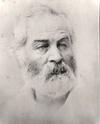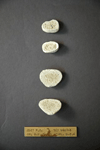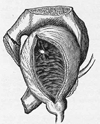Remains of War: Walt Whitman, Civil War Soldiers, and the Legacy of Medical Collections
- PMID: 22741042
- PMCID: PMC3381362
- DOI: 10.1179/mhj.2012.5.1.7
Remains of War: Walt Whitman, Civil War Soldiers, and the Legacy of Medical Collections
Abstract
The National Museum of Health and Medicine holds a collection of anatomical specimens from nearly 2,000 soldiers injured during the American Civil War. Originally collected as part of a study of trauma and disease during war, these specimens have been museum artifacts for over 140 years. During this time, they have been displayed and utilized in an array of interpretative strategies. They have functioned as medical specimens documenting the effects of gunshot wounds and infection to the human body, as mementos mori symbolizing the refuse of a nation divided by war, and as objects of osteological and forensic interest. The museum's curators recently discovered four of these specimens from soldiers who the poet and essayist Walt Whitman nursed in the wartime hospitals of Washington, DC. Uniting these remains with Whitman's words yields a new interpretation that bears witness to individual histories during a time of unprecedented conflict in American history.
Figures







References
-
- Hammond WA. Circular Number 2. Washington City: Surgeon General's Office; 1862.
-
- Morris R., Jr . The Better Angel: Walt Whitman in the Civil War. New York: Oxford University Press; 2000.
-
-
See for example Cassman V, Odegaard N, Powell J, editors. Human Remains: Guide for Museums and Academic Institutions. Lanham, MD: AltaMira Press; 2007. Lindee MS. Osiris 13. 1998. The Repatriation of Atomic Bomb Victim Body Parts to Japan: Natural Objects and Diplomacy; pp. 376–409. Williams E, editor. Human Remains: Conservation, Retrieval and Analysis. Proceedings of a conference held in Williamsburg, VA, Nov 7–11, 1999. Cambridge, England: Archaeopress; 1999.
-
-
-
See Dahlbom T. Matter of Fact: Biographies of Zoological Specimens. Museum History Journal. 2009;2(1):51–71. Daston L. On Scientific Observation. Isis. 2008;99:97–110.
-
-
- Medical and Surgical History of the War of the Rebellion. Washington, DC.: Government Printing Office; 1879–1885.
Grants and funding
LinkOut - more resources
Full Text Sources
